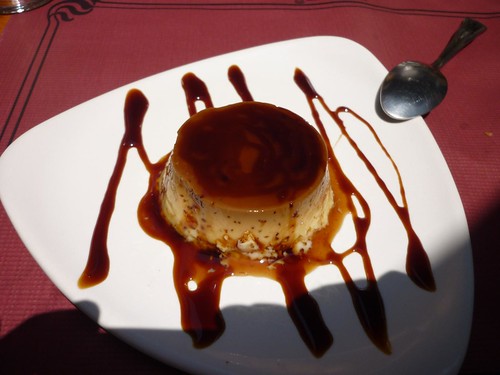Flan Posted by Magda on Oct 19, 2010 in Spanish Culture
Hay tradiciones, costumbres, y platos típicos que uno tiene tan asimilados, que se sorprende cuando descubre que fuera de su ciudad, o de su país, no se conocen. De la misma forma en que he visto a amigos extranjeros disfrutar comiendo, y cocinando, una tortilla de patatas, los he visto relamerse de gusto ante un postre muy sencillo, pero delicioso: el flan. Este postre era la receta especial en las celebraciones de mi infancia, aunque eso sí: siempre había que vigilar que nadie se lo comiese entero, ¡y nos dejase al resto a dos velas!
Como veréis, ni los ingredientes necesarios, ni el proceso para hacerlo, son nada complicados. Necesitaremos:
– Media docena de huevos
– Un litro de leche
– Dos cucharadas de azúcar por huevo (o sea 12, aunque se pueden dejar en 10 si no nos gusta demasiado dulce, o incluso usar azúcar moreno)
– Caramelo líquido, que podemos optar por comprar preparado, o ya que estamos puestos, hacerlo nosotros mismos.
Si optamos por hacer el caramelo, será tan fácil como poner tres cucharadas soperas de azúcar y una de agua en una sartén, y derretirlo a fuego lento. Debe cobrar un tono tostado, pero no demasiado, porque podría quedar amargo. Ponemos el caramelo en una flanera, untando bien las paredes.
En un cuenco, batimos los huevos, y los mezclamos con la leche y el azúcar. Vertemos todo en un molde, y lo ponemos al baño María (o sea, la flanera dentro de una olla con agua hirviendo, pero sin rebosar) durante una hora, pasada la cual, lo pincharemos con un cuchillo. Si sale limpio, significará que el flan está cuajado bien por dentro, y por lo tanto, listo. Si no, lo dejaremos un poquito más.
Una vez retirado del fuego, lo dejamos enfriar a temperatura ambiente, lo metemos en la nevera para que esté fresquito cuando vayamos a comerlo, y solo quitaremos el molde para servirlo. Aviso a los impacientes que quieran tomarlo caliente: ¡os dolerá la tripa!
There are traditions, customs, and common dishes that become so familiar to you that you get shocked when you find out that, outside your city or country, they are completely unknown. I’ve seen some of my foreign friends enjoy eating or cooking a Spanish omelet, and also drooling before a very simple, yet delicious, dessert: flan. This dessert was the special recipe for celebrations during my childhood. However, you had to keep a close watch to make sure that nobody ate the whole thing, leaving the rest of us without it!
As you will see, there is nothing complicated at all about the ingredients or the process. We will need:
-Half a dozen eggs
-Two pints of milk
-Two tablespoons of sugar per egg (up to 12, although you can stop at 10 if you don’t like it too sweet, or if you’re using brown sugar)
-Liquid caramel that we can buy from the store or, while we’re at it, we can make ourselves.
If we opt for making the caramel ourselves, it’s as easy as putting three tablespoons of sugar and one tablespoon of water in a frying pan and simmering it until it melts. It has to turn brown, but not too dark, or it might become bitter. We pour the caramel into flan molds, making sure the sides are well covered.
In a separate container, we beat the eggs, and then we mix them with the milk and sugar. We pour the mix into the molds, and cook them in a bain-marie (that is, the flan mold inside a pan that is almost fully submerged in boiling water) for an hour. After that, we should stick a knife into the flan. If it comes out clean, it means the flan is fully set inside, and ready. Otherwise, we have to leave it for a little bit longer.
Once removed from the stove, we let it cool down at room temperature, and then put it in the fridge so that it’s chilled whenever we want to serve it, just by removing the mold. A warning for those of you impatient enough to try it while it’s still warm: you will get stomach ache!

Build vocabulary, practice pronunciation, and more with Transparent Language Online. Available anytime, anywhere, on any device.




